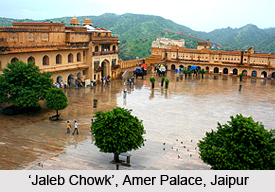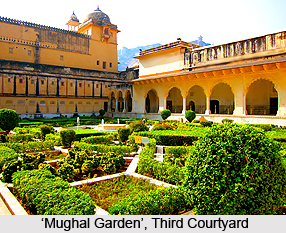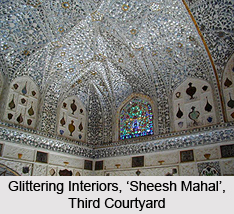 Courtyards of Amber fort or Amer Palace, Jaipur, Rajasthan are marvellous instances of Hindu architectural characteristics which beautify the interiors of the majestic palace grounds. Visitors to Amer Fort will come across four different courtyards, which comprise Sila Devi Temple, Sheesh Mahal and several other impressive structures.
Courtyards of Amber fort or Amer Palace, Jaipur, Rajasthan are marvellous instances of Hindu architectural characteristics which beautify the interiors of the majestic palace grounds. Visitors to Amer Fort will come across four different courtyards, which comprise Sila Devi Temple, Sheesh Mahal and several other impressive structures.
`First Courtyard` of Amber Fort
One can approach the main official palace grounds through a staircase from Jaleb Chowk, and the Sila Devi Temple is located on the right side of the stairs. Historical sources have stated that Rajput kings like Man Singh offered worship to the Goddess in 16th century, till the 1980`s and buffalo sacrifice which was a prevalent norm at the temple was finally ceased. The private chambers of the Maharajas are accessible through the `Ganesh Pol` or `Ganesh Gate`, named after Lord Ganesha. It was constructed by Raja Jai Singh and contains beautiful frescoes, above which is present the `Suhag Mandir`. Suhag Mandir was complete with latticed windows which permitted royal womenfolk to witness functions organised in the `Diwan-e-Am`.

Sila Devi Temple
Sila Devi temple is dedicated to `Sila Devi` who is considered a divine avatar of Goddess Durga or Goddess Kali. A silver sheet embossed double leaf gate greets visitors to the temple wherein the presiding deity is placed beside two lions composed of silver. A legendary tale suggests that Goddess Kali had instructed king Man Singh in his dream to establish Her idol here and worship Her after collecting it from underneath the sea, for emerging victorious against the king of Jessore in Bengal. The king followed the divine order and named the deity `Sila Devi` since it was carved from a single slab of stone. The temple also possesses an idol of Lord Ganesha made from coral. Yet another legend asserts that a black stone slab was offered to Man Singh after he defeated Raja of Jessore which was related to a tale in Mahabharata wherein siblings of Lord Krishna were assassinated by Kansa on this very stone. It is believed that Man Singh had returned the captured land of Bengal to king of Jessore after he received the holy gift. The image of Goddess Durga as `Mahishasuramardini` was carved on the stone at that point of time and installed at the temple as Sila Devi.
Second Courtyard of Amber Fort
The Diwan-e-Am is present in the Second Courtyard and consists of a double row of columns. 27 colonnades were there on a raised platform in Diwan-i-Am, engraved with images of an elephant-shaped capital. It was here that the king held audience and heard public petitions.
Third Courtyard of Amber Fort
The Third Courtyard is home to the private quarters of the royal family, and generally sheltered attendants who worked for the family members. One can reach this portion of the palace through Ganesh Gate which is adorned with sculptures and mosaics. Two buildings are present in the premises of the palace, which separated by the Mughal Gardens. Jai Mandir, which is situated on the left side of the gate, is enriched with multi-shaded ceilings and glass engraved panels, wherein the glasses employed are convex mirrors. The mirrors have been painted and coloured with foils. Due to the existence of numerable glasses, the Sheesh Mahal or `Mirror Palace` is so named and the mesmerizing beauty of the collection of so many mirrors sometimes make it appear as a `glittering jewel box in flickering candle light`. The walls are decorated with carved marble relief panels.

The `Sukh Mahal` or `Sukh Niwas`, also known as `Hall of Pleasure` is existent just opposite to the Jai Mandir which can be easily accessed through a sandalwood door embellished with rich marble inlay.
There exists a fresco embedded on the surface of a pillar near the marble palace which consists of the images of two butterflies hovering near a flower, known as the `magic flower`. Images of a lotus, hooded cobra, a scorpion and corn`s cob, elephant trunk and also a fish tail are carved onto the wall and they can be witnessed only by placing one`s hands in a particular manner, which hides the panel. The Palace of Man Singh I is said to be the most ancient portion of the Amer Palace, which was built in 25 years. A pillared pavilion is present at the central part of Amber Fort which possesses coloured tiles and frescoes. This `baradari` or pavilion was employed as the venue of official meetings by the royal queens and therefore it was shaded with curtains for the purpose of maintaining privacy.
Tourists will also notice a garden which was created by Mirza Raja Jai Singh and had been influenced by the Mughal Garden or `Chahar Bagh`. It is hexagonal in shape. Narrow channels accompanied by marble slabs is located at the middle portion of the garden is equipped with a beautiful fountain. The garden is cultivated by the water from cascades of water which originates from Sukh Niwas. Three gates or `Tripolia Gate` enables one to approach the palace from the western side and they lead to three different directions, one to `Zenana Deorhi`, another to Jaleb Chowk and the final one to Man Singh Palace. There is yet another gate called as `Lion Gate` was once protected by a guarded gate which helps people to reach the private chambers of the palace.
Fourth Courtyard of Amber Fort
The royal womenfolk of the palace used to dwell inside the grounds of Fourth Courtyard, which is known as the royal `zenana`. It is believed that is was here that the royal wives and the concubines of kings used to reside. This region comprises living rooms which opened out into a common corridor. `Jas Mandir` is a hall of private audience of the Maharajas which is beautified with alabaster relief work and floral glass inlays.




